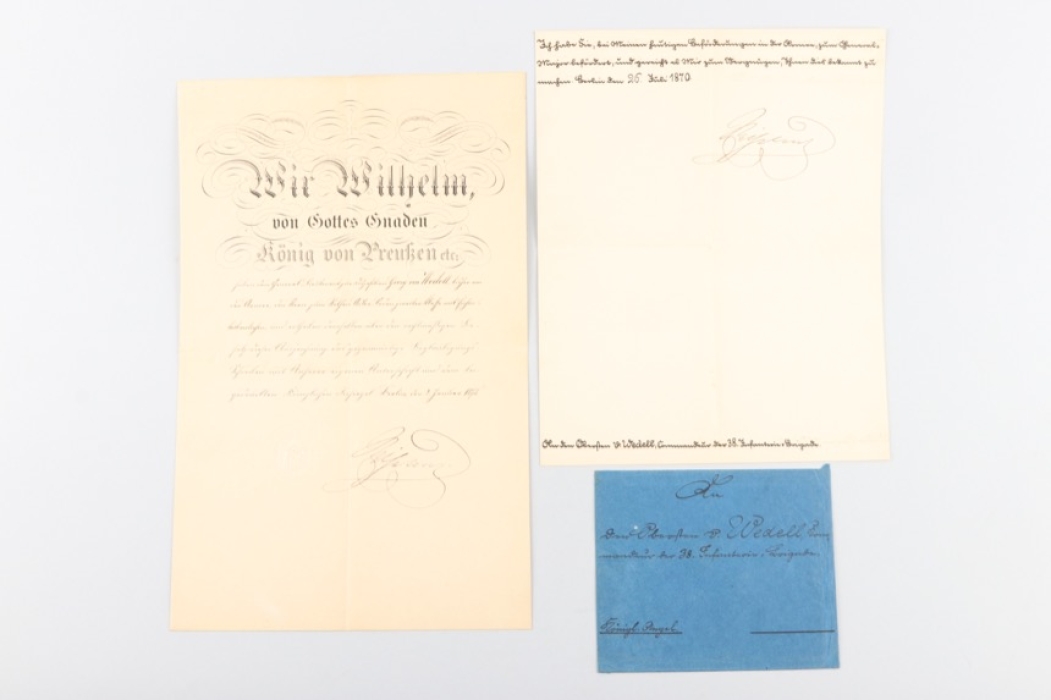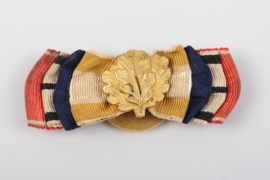2nd class cross with oak leaves
Buy treasures for a reduced Buyer‘s Premium

PRUSSIA - RED EAGLE ORDER CROSS 2ND CLASS WITH OAK LEAVES
MILITARIA PRICE GUIDE
How can I see prices?
Welcome to the ratisbon's MILITARIA PRICE GUIDE!
To access all prices, pictures, and descriptions please subscribe to our MILITARIA PRICE GUIDE at www.ratisbons.com/militaria-price-guide. Save 25% when subscribing for one year! Get full access for just 75€!
We are buying single items and entire collections! Call +49 8541 9053699
-
PAYMENT
-
HOW CAN I PAY FOR MY ORDER?
AUCTIONSYou will receive an e-mail confirming your successful bids the day after the auction has ended. In your personal my ratisbon's you will be able to inform us about your most convenient payment method for this order or tell us about an alternative shipping address.
If we don’t hear from you within 24 hours, we will send an invoice choosing the payment and shipping options which we think are the most comfortable ones to you. If you decide to change your shipping or payment method after receiving your invoice, just drop us a line or visit my ratisbon's/ORDERS for any more details.
SHOP ORDERSChoose your payment method when ordering and submit your order. Once your order has been received we will send an invoice including your shipping costs and your payment instructions.
After receiving the invoice, the order must be paid within 7 days.
Please contact us to discuss layaway options.To learn more about paying at ratisbon's, please see your FAQ pages.
WE ACCEPT FOLLOWING PAYMENT METHODS
-
-
Versand
-
HOW DO YOU SHIP MY NEW TREASURES?
PACKING & TRACKINGWe usually send out orders within 1-3 working days after your payment has been received. In most cases, we are faster than this! We will inform you when your goods are being dispatched and provide a tracking number, In addition, you can always check your order status at my ratisbon's/ORDERS. Delivery times will vary depending upon the delivery destination and type of shipping service you have chosen.
SHIPPING TO ALTERNATIVE ADDRESSIf you prefer to have your order shipped to your work address or a friend during your absence, we will happy to arrange this for you. Send us an email letting us know about your new shipping address and we will be happy to send an updated invoice to you.
OUR LOGISTIC PARTNERS ARE AS FOLLOWS
-
-
OUR GUARANTEE
-
 OUR GUARANTEE!
OUR GUARANTEE!We only offer collectables which to the best of our specialists knowledge are authentic. About 15% of all consignments are returned to the consignor after extensive research due to authenticity issues.
Unlike traditional auction houses we do offer a full right of return. If you are not satisfied with what you won or bought, you may return it within 14 days. Please inform us and we will instruct you on how to return the goods. For more information, please visit FAQ pages.
Important note: Cancelling bids after an auction may disappoint the consignor, who like you is a collector. This situation is easy to avoid. We encourage you not to bid on any collectable if you are unsure if it fits into your collection. Ask us to cancel your bid 24 hours prior to the end of an auction to avoid this situation.
-
COUNTRY Imperial Germany
DIMENSIONS
WEIGHT
 US LOT US1-496
US LOT US1-496EAN 3000000003244
 US LOT US1-496
US LOT US1-496PERIOD until 1918
COUNTRY Imperial Germany
COUNTRY Imperial Germany
 US LOT US1-496
US LOT US1-4962nd class cross with oak leaves
Description
Two documents to General Georg von Wedell. He received the two classes of the Iron Cross and the Oak Leaves for the Order Pour le Mérite, for the successful defense of Beaune-la-Rolande
- an award document on the Prussian Red Eagle Order 2nd Class with Oak Leaf, awarded on January 2, 1875. Original ink signature from Wilhelm.
- Promotion document in form of a so called “Kabinetts Ordre” (informal order) to Oberst von Wedell from July 26, 1870. Promotion to General-Major. Original ink signature from Wilhelm. With fitting blue postal envelope with wax seal.
Georg was the son of the Prussian officer Wilhelm Sigismund von Wedell (1772–1827) and his wife Friederike Wilhelmine Christiane, née von Gregorski (1780–1851). His father was a captain a. D. and was last in the 3rd Battalion of the 9th Landwehr Regiment.
Wedell visited the cadet houses in Kulm and Berlin . He then joined the Guard Artillery Brigade of the Prussian Army on August 5, 1837 as a Second Lieutenant . From October 1, 1837 to July 15, 1839 he was assigned to the United Artillery and Engineering School. For further training followed from October 1, 1843 to July 15, 1846 as Prime Lieutenant (from October 10, 1842) the command to the General War School . During the Baden campaign , Wedell and the 7th Artillery Brigade took part in the siege and capture of Rastattpart. In 1850 he was assigned to the topographical department of the Great General Staff . At the same time as he was promoted to captain, he transferred to the 6th Artillery Regiment on July 22, 1852 , where he served as the battery chief from May 1, 1855 . From here Wedell was transferred to the General Staff on January 13, 1858 and promoted to major on July 12, 1858 . At the same time he was from October 1, 1859 to July 1, 1960 teacher of war history at the General War School. He was then transferred to the General Staff of the 16th Division . After his promotion to lieutenant colonelon March 17, 1863, on August 12, 1863, he was appointed commander of the 1st Battalion of Infantry Regiment No. 26
Two years later, from June 13, 1865, he was commander of Infantry Regiment No. 17 and promoted to colonel in this position . After only ten months, on April 3, 1866, he was transferred to the War Ministry , where he worked as a department head. When the German War broke out in June 1866, he became the commander of Infantry Regiment No. 31. He took command of the campaign in Bohemia, his regiment belonged to the 7th Division under General von Fransecky . The most important mission in this war was in the battle of Königgrätz: The 7th Division stopped the attack of two Austrian army corps in the battle for the Swiepwald. The battle for the Swiepwald was one of the key points in the battle. In this battle the regiment lost ten officers and 208 soldiers. For services in battle, Wedell received the order Pour le Mérite on September 20, 1866 .
With the mobilization in July 1870 on the occasion of the war against France , Wedell was given command of the 38th Infantry Brigade ( Regiments No. 16 and No. 57 ), which was part of the 19th Division ( Schwartzkoppen ) in the X Army Corps ( Voigts-Rhetz ). The first combat mission was in the battle of Mars-la-Tour on August 16, 1870. The fight began as an attack by the German III. Army corps against French troops moving from Metz towards Verdundeducted. What was planned as an attack against the rearguard of the French turns out to be a battle with the head of five entire army corps. Less than 30,000 German soldiers faced almost 130,000 French here. Wedell was on the way to the Maas with his brigade to intercept the French Rhine Army , which was supposed to be withdrawing , but was then sent to Mars-la-Tour as reinforcement. He arrived there around 4 p.m. after a day's march of almost 12 hours. Wedell received the order to attack the flank of the French army. Since there was no reconnaissance and the hilly terrain did not allow a good overview, this attack did not lead to the flank, but to the center of the IV French Corps ( Ladmirault). His two regiments came into the crossfire of two French divisions ( Grenier and Cissey ) when attacking the heights of Bruville .
Within less than 30 minutes, his regiments suffered the loss of 73 officers and 2543 men, including over 400 prisoners, and had to withdraw completely defeated. The two regimental commanders were among the dead. The soldiers had not even made it here to get the French troops in firing range of their guns. One cavalry attack onlyIt was thanks to the Guard Dragoons for relief that the regiments were not completely wiped out, but were able to break away from the enemy. A French counterattack was carried out with only one brigade and could therefore be repulsed when the French came within range of the German rifles. Wedell himself was wounded and his horse had been shot from under him.
After the battle, Wedell remained in reserve with the rest of his brigade at the Battle of Gravelotte and then stayed until the end of October 1870 as part of the Siege of Metz . Here he took part in the battle of Noisseville . After the fall of Metz on October 27, 1870 Wedell went with the 2nd Army under Friedrich Karl Nikolaus von Prussia to the area south of Paris on the Loire . Here the new French government had the Loire Armyset up. This army was numerically far superior to the German troops, but consisted to a large extent of volunteers and reservists, a few soldiers and dispersed. In order to intercept this army and thus secure the siege of Paris , the German troops marched in forced marches of around 25 km per day towards the Loire.
On November 28, 1870, the battle of Beaune-la-Rolande took place here . Two French corps with a total of 60,000 soldiers attacked three German brigades one after the other. The 38th Brigade under Wedell was supposed to hold Beaune-la-Rolande. At this point in time there were only 13 companies with a total of around 1200 men. During the fighting, the men of the 57th Infantry Regiment even set fire to the makeshift barricades to repel the attack. During the battle, the German soldiers used up almost all of their ammunition by early afternoon and were only saved by reinforcements from the 5th Division . At Mars-la-Tour Wedell was the 5th Division under Stülpnagelcame to the rescue, at Beaune-la-Rolande it was the other way around. The battle had thrown back the right wing of the Loire Army. For the successful defense of Beaune-la-Rolande, Wedell received the two classes of the Iron Cross and the Oak Leaves for the Order Pour le Mérite.
He took part in the Battle of Orléans in December 1870 , but fell ill in January 1871, so that he could not lead his troops in the Battle of Le Mans .
After the armistice, Wedell was still part of the occupation force in France. In November 1873 he then took over the 4th Division in Bromberg . In this role, he was promoted to lieutenant general in December 1873. On April 4, 1874 Wedell retired from active service, he was transferred to the officers of the army and to be on January 2, 1875 resignation out under award of the star to the Red Eagle . II Class with oak leaves with board for disposition made.
In 1879 he was accepted into the Frankfurt Freemason Lodge "Socrates for steadfastness". He later took up residence in Leer (Ostfriesland), where he died on March 27, 1894.
Condition
1-
Seller
History Trader Inc., 521 Thorn Street #165, Sewickly, PA 15143-0165, USA
Friedrich Wilhelm II., King of Prussia, resurrected the Brandenburg Red Eagle Order on June 12, 1792, as a single class order. King Friedrich Wilhelm III added a 2nd and 3rd class to the order on January 18, 1810, creating today's well-known design. At first, the decorations of the 2nd and 3rd class were identical in size.
The cross of the order was designed as a Latin cross in white enamel, showing the red Brandenburg eagle on a white enameled center medallion. The reverse medallion showed the cypher “FW” for its founder Friedrich Wilhelm. The star was eight pointed and has a white enameled center showing again the red Brandenburg eagle surrounded by the golden orders motto in between silver pearled rings: “Sincere et constanter” (aufrichtig und beständig), terminated on the bottom by a laurel wreath.
All those who had been awarded the 3rd class before being promoted to the 2nd class of the order received a golden oak leaf attached to the ring of the higher class. This change to the statutes was made on January 18, 1811. Only those knights of the order that received the 3rd and later 2nd class could wear the oak leaf on the 1st class decoration and star.
Inspired by the different sizes of the Russian Order of St. George, the king verbally changed the size of the 3rd class decoration to a smaller version on December 21, 1817.
The structure of the order was amended on January 18, 1832. First, the General Service Cross was promoted into the order, redesigned, and re-named the 4th class Red Eagle Order. Also, the 2nd class could now be awarded with (or without) a newly created star. The rules for the oak leaf applied for the star as well. Finally, the eagle design was changed, by personal intervention of King Friedrich Wilhelm III, to a more pleasing look, which now incorporated the Hohenzollern Coat of Arms.
Analog to the oak leaf, a bow was created on January 22, 1832, to be worn above the ring of the 3rd class of the order by those who had previously been awarded the 4th class.
With King Friedrich Wilhelm III.’s order of January 17, 1846, the 4th class was redesigned and featured from then on an enameled center medallion just like on all higher grades. In addition, the design of the eagle was again updated for all classes.
The swords were created on September 16, 1848, for merit during war and affixed through the medallion. If a recipient was promoted to a higher grade and had been awarded the lower grade with swords, the swords of the lower grade were mounted on the ring of the cross of the higher grade, and on the star (if awarded) above the center medallion.
On February 11, 1850, Crowns and Scepters were awarded to a few recipients who facilitated the suppression of the 1848/49 revolution. Because the revolution was viewed as a heinous, treasonous act, the recipients did not wish to be promoted to a higher grade of the Red Eagle Order for their part in suppressing it. Honoring their wishes, the king awarded the devices as additions to their existing orders.
To honor non-Christian recipients, who were thought to be potentially sensitive to the orders cruciform design, a special star and round design of the Red Eagle Order was created on February 26, 1851.
On December 19, 1851, the king created a special jubilee number to be worn on either the oak leaf or the bow, or as a plaque on the decoration itself, for those celebrating a minimum of 50 year service. For 60 years of service the number “60” was awarded with the Red Eagle Order.
The stars to the 1st and 2nd class were originally embroidered from textile and metal thread. On February 26, 1857, they were ordered made of solid silver and gold. The design differs from the design we know from the last model after July 31, 1854 to approximately the middle of the 1860th.
Numerous complaints from the recipients of the specially designed Red Eagle Order for Non-Christians finally convinced Wilhelm I. to permit recipients to exchange their decorations for those of regular design. On July 5, 1861, Wilhelm I. ordered that, from then on, awards of the Red Eagle Order for Non-Christians were to be made at his personal command only.
As of October 12, 1861, Prussians promoted to a higher grade of the Red Eagle Order who had received swords for bravery on the lower grade, were to wear the oak leaf on the 1st and 2nd class, as well as the bow on the 3rd class, in addition to the swords on ring.
King Wilhelm I. created the Grand Cross of the Red Eagle Order with Star and Collar Chain on Coronation Day, October 18, 1861, in a new and different design to the existing one. The Brandenburg Eagle moved from the center of the order fourfold in between the now Maltese shaped cross arms.
On October 18, 1864, it was ordered that all St. John knights who volunteered to care for the wounded wear a miniature St. John cross on the ring, bow or oak leaf of all Red Eagle Order decorations. This statute was adapted only for the wars in 1864 and 1866.
The manner of wearing the Crown Order and Red Eagle Order simultaneously in the 1st class was redefined on January 18, 1865. Wearing both at the same time was no longer permitted. Instead, recipients were to wear only the order they received first, and an enameled ribbon of the order not worn was affixed around the cross center and the stars medallion. The ribbon of the Red Eagle Order was worn on the Crown Order if the recipient had received the Red Eagle Order first, and vice versa. This custom was abandoned May 4, 1888. From then on, the star of the initially awarded order was not worn anymore but the cross worn on the neck on a narrower ribbon after the statue.
Various changes and adaptations planned by the 99 day emperor Friedrich III. to streamline the Prussian Order system and especially the Red Eagle Order were reverted by Wilhelm II.
With the 100-year jubilee of the creation of the Red Eagle Order in 1892, the crown to the order was created. Wilhelm II. would award the crown personally on special occasions only. However, the crown did not represent another level within the order.
On January 7, 1914, Wilhelm II added the so-called Kleindekoration, a smaller version of the Grand Cross and 1st Class Set. These were to be worn on the coat, mess coat and hunting dress.
With the First World War degenerating into a long and costly trench warfare, precious raw materials grew scarce. Even the materials used for medals and decorations became subject to strict scrutiny. Following similar proclamations in other German states, Prussia mandated that medals and decorations should be made from replacement materials. The General Orders Commission ordered on October 10, 1916, that gold-based decorations should be crafted only from gilt silver with a silver content of 938/1000. By Prussian law those decorations had to be marked with the content mark 938 and the manufacturers control mark. The Prussian Red Eagle Order has compared to all other Prussian and European Orders the most variations within its structure.



